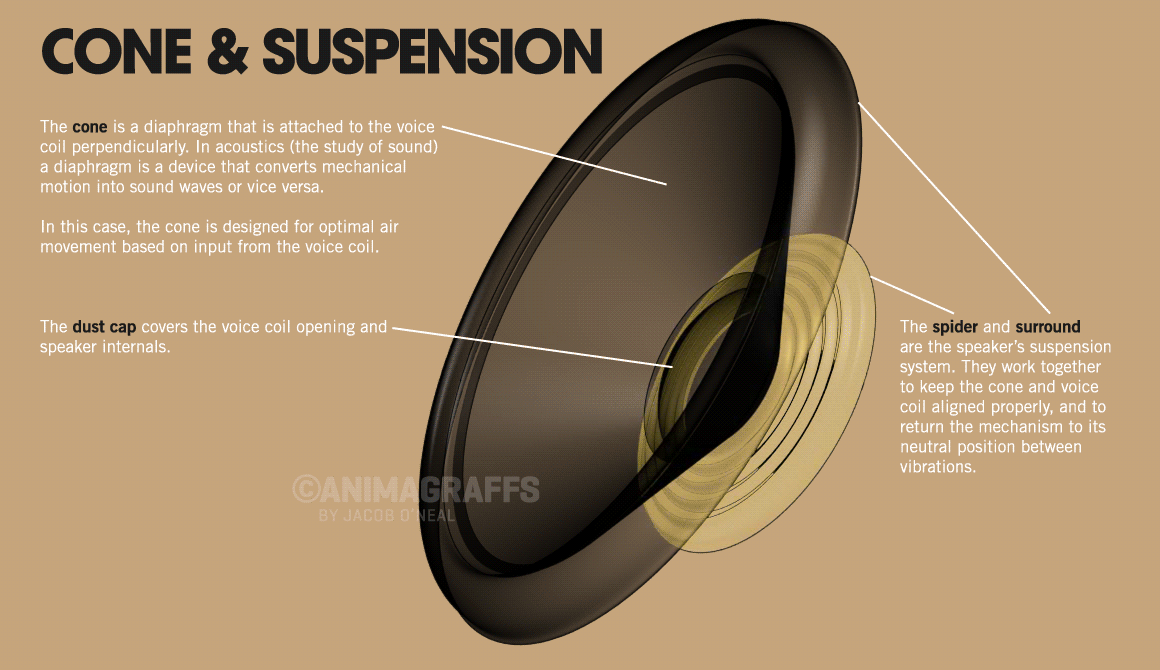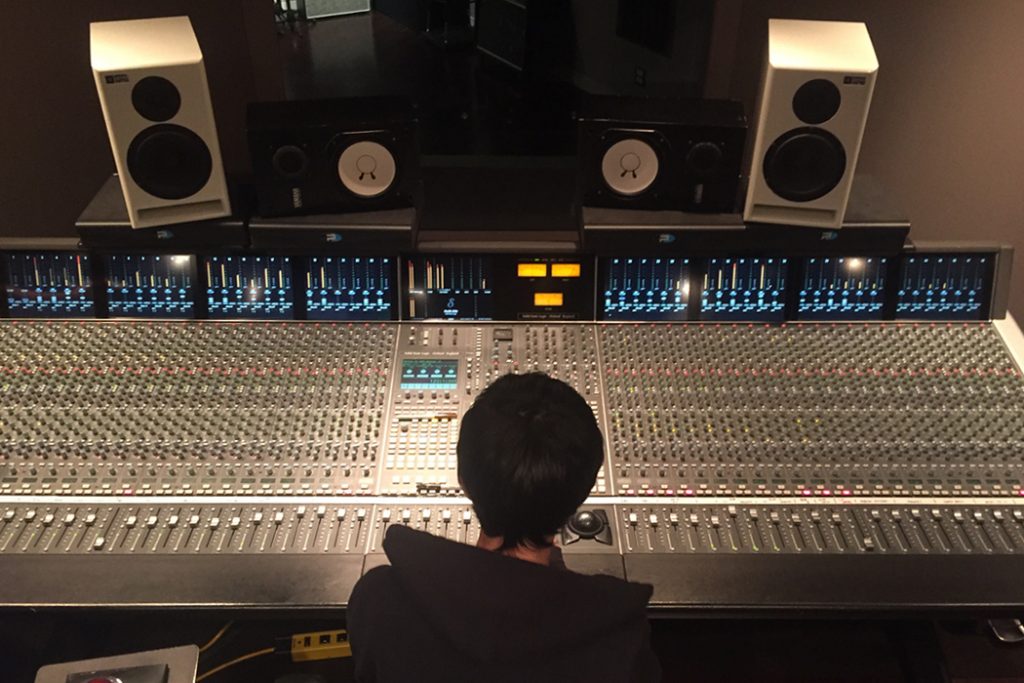
+ Learning to record and mix your vocals at home? Check out Soundfly’s popular online music production courses today! Subscribe for unlimited access here.
Almost everyone owns multiple sound-producing devices these days. They’re in our smart phones, our car stereos, home theater sound systems, and just about every other electronic device. Most of us take for granted the ingenious way in which the speakers in these devices make all those noises; so to help us gain an appreciation for all our amazing devices, let’s explore the basic principles of what makes a speaker work.
But first, we need to have an understanding of how sound and hearing work. Our ears provide our sense of hearing by capturing sounds in the air that are funnelled through the ear canal to the eardrum, which then conveys the sound to our brain through a series of physiological processes (i.e. inner ear mechanisms).
The “sound” that is being captured is not actually sound at all until our brain has interpreted it as such. Ears capture a series of vibrations in the air around us — they sense repeating patterns of pressure changes, increases and decreases, when they hit the ear canal. These are airborne pressure waves created by disturbances in the atmosphere around you, for example when two things crash into each other in the air, or something falls and hits the ground, or someone yells, or a musical instrument is playing.
You may have seen waves in the ocean, or rolling disturbances in a grass or wheat field, or ripples on a pond or lake surface when you throw a rock into it. All of these are examples of waves: Disturbances traversing through the material that has been affected, creating repeating peaks and valleys as a result. They all work in a similar manner to how sounds are transmitted through the air. In the case of sound, the propagation of pressure disturbances in the air is most similar to the ripple you would see if you were to flick the end of a Slinky or any long spring.

When we speak or sing or make any other sound, we are forcing air molecules closer to each other. This is like tossing a rock into a pond, which causes the water molecules to compress closer to each other, or flicking the end of a Slinky, which causes the spring coils at that end to compress closer to each other. If you’ve ever pushed against a spring you’ll know that it always wants to spring back outward to its original state.
Similarly, in all of these examples the medium will want to push back to its original state before the disturbance, so it will now uncompress that region of air. This uncompressing release of the pressurized material will then affect that material around it, causing the surroundings to then become pressurized, and so the cycle repeats and continues propagating outward or forward along the path in which it was initially directed, oscillating between compressed and uncompressed regions as it travels.
These are like the ripples we see in the pond when we toss a rock into it. In the case of sound, it is made of compressed and uncompressed regions of air molecules, invisible to our eyes.
So how is this oscillating pressurized air translated into what we hear as sound by our ears?
If there is a single impact, such as something falling and hitting the floor, you hear that single “thump” as recognition of one wave of pressure hitting your ear. But, in the case of musical sounds, which we refer to as tones, the sound that is created is actually a series of repeating light thumps of pressure changes that occur in regular patterns. Your brain translates these repeating cycles as a particular tone: slower repeating patterns are heard as lower tones and faster repeating patters are heard as higher tones. If the repeating pattern is too slow or too fast we can’t hear it; these are known as subsonic and ultrasonic sounds respectively.
To test out how this works, flick one of the tines of a comb and you’ll notice it will simply make a “click” sound. But if you run your finger quickly along all the tines it will sound like a buzzing high-pitched tone. This is the basic process of how our sense of hearing translates a series of repeating pressure waves into the tones that we all recognize.
Now with our basic understanding of how hearing works, we should realize that a speaker will need to be a device that can produce various repeating sequences of compressed and uncompressed air propelled in the desired direction. After all, that’s what naturally created sounds would have produced. So our speaker needs to reproduce the same type of pressure disturbances as the original sound it is attempting to convey.

One of the easiest ways to visualize this happening is through use of a flat wide surface that can push air forward to compress it and pull air back to uncompress it. Using this type of system we could simply increase or decrease the rate at which the air is alternately pressurized and de-pressurized in order to create a desired tone, and we can also push it to a greater or lesser degree to mimic louder or softer sounds. To be able to have a wide flat surface acting as our air “plunger,” which can move quick enough to produce even the highest pitches that human ears can hear, it’s most practical to have the surface material very thin and light weight so that it can be moved easily.
Most speakers are therefore made of thin, lightweight materials, such as paper, aluminum, or special composite materials. But we also don’t want the air we just compressed in front of the speaker surface to simply wrap around the back of the speaker surface to fill in the decompressed air it leaves behind it. This is why speakers need to be contained within some kind of enclosure, or be built into a wall or other surface, to discourage the air from simply seeping around the edges and out towards the space behind it.
The movement of the surface of speakers is most often produced in one of two ways, both of which use electricity, which is why speakers are to be found in electronic devices nowadays (as opposed to the gramophone, for example, which did not use electricity). The first method uses the interaction between a standard magnet and electricity in the form of an electric magnet. The second method uses piezoelectric ceramics, which are materials that change size when an electrical current is applied to them.
The first is the more traditional method by which speakers have been produced, and is still most commonly used for larger speakers, such as in cars, studio monitors, and home theater sound systems. With this method, a ferrous magnet (usually a cylindrical iron block) is located directly behind the speaker surface. Then a coil of wire is attached to the back of the speaker surface and placed around the magnet so it can move freely back and forth around the magnet in some fashion. Imagine your finger is the magnet and the coil of wire is like a ring that can slide up and down your finger.

You may recall from your high school science class, or perhaps your favorite Bill Nye episode, that when an electrical current is sent through a coil of wire it turns the coil into a magnet. You may have even done an experiment of wrapping wire around a nail and connecting both ends of the wire to a battery to turn the nail into an electric magnet that you can use to pick up small pieces of metal as long as it is connected to the battery. In this same fashion, if we send an electrical current through the coil of wire within our speaker it will produce a magnet field as well.
You may also recall that magnets have two ends generally referred to as their poles, typically labeled North and South. When two magnets are placed next to one another with the same poles facing toward each other they will want to push away from each other. If they have different poles facing each other they will pull toward each other. Since our speaker has a coil of wire that has now turned into an electric magnet by having electrical current applied, it will either be attracted to or repelled from the magnet it surrounds depending on which polarity each has.
If we control the direction of the electrical current applied to the coil of wire, positive or negative, we alternate the poles of the electric magnet we created and the opposite effect will be accomplished. At this point it’s simply a matter of applying alternating current with a desired cycle frequency in order to produce the sound tone associated with that oscillating pressure cycle. And we make it louder by pushing more current through it.
The second common modern method to making a speaker is typically used in smaller electronic devices, such as handheld electronics, smart phones, ear buds, etc. In a device like this, there simply isn’t enough space to put a wide flat surface with a coil of wire and a magnet behind it, not to mention we usually don’t to stick a heavy iron magnet into our ears. So in these cases, we’ll utilize piezoelectric ceramics since they can be made very small and thin. Most piezoelectric speakers use plastic or aluminum surfaces to pressurize the air as they move, as these materials are more durable for using in small packages.
Piezoelectric ceramics are materials that rearrange their molecular structure in response to an applied electrical current. Generally when electricity is applied to them the molecules line up which causes the material to expand. The more current supplied, the more they expand. If we place a flat surface on the top of the piezoelectric ceramic and alternate the applied current this will produce oscillating pressure cycles that in turn create our tonal sounds.
Since these types of speakers are very small, they fit quite well into portable devices like smart phones. Plus they are very light and don’t take much power to operate. However, they can’t produce sounds nearly as loud as our magnet-based speakers primarily because they aren’t as large and don’t have as much power applied to them.
So now you know how your speakers produce sound. There are a number of “build it yourself” speaker kits available for purchase online, many of which are fairly inexpensive. Go ahead and give one a try!
With your newfound understanding of how a speaker works, it should be a breeze for you to build a speaker of your own and you will likely recognize all the elements that have been mentioned here. But, most importantly, you’ll likely never take for granted again how amazing it is that we can recreate natural sounds with good reproduction quality using such a relatively simple mechanism.
Continue learning with hundreds of lessons on mixing, DIY home recording, electronic music production, beat making, and much more, with Soundfly’s in-depth courses, like Modern Pop Vocal Production, Advanced Synths & Patch Design, and Modern Mix Techniques. Subscribe for unlimited access here.




